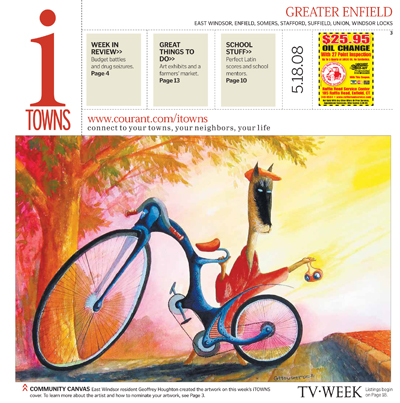Last night I had the pleasure of moderating a panel on “The Future of Journalism,” featuring a group of reporters and former reports from the broadcast, print and online media. This panel was perhaps not representative of the media world these days, since all of the members are involved in digital initiatives of some sort at their organizations. But all come from conventional media backgrounds, and I found their optimism to be refreshing.
Panelists included Ted McEnroe, Director of Digital Media at New England Cable Network; Robin Lubbock, Director of New Media at WBUR radio; Howard Sholkin, Director of Communications & Marketing Programs at IDG Communications; and David Wallace, Managing Partner of Gamechange LLC and a professor at Emerson College.
All the panelists noted that newsrooms in their organizations were having some difficulty bridgingt the divide between the specialty journalist, who does one thing well, and the new journalist, who’s expected to work in multiple media with almost equal facility. Some veteran reporters simply haven’t been able to make the change, they noted, and their organizations are tolerating that fact. When journalists can’t make the transition to a new style of reporting, management is ultimately to blame, they said. Retraining is critical right now.
It was clear that the old walls that separated different kinds of media from each other are fallng. Robin Lubbock cited some recent stories by his radio station that demanded a visual component. In the past, the reporters would have had to do the best they could within the limitation of audio, but today they can post images on the website and send interested listeners there. This has added a wonderful new dimension to the craft of audio journalism and has energized the reporters, he said.
IDG’s Sholkin commented that the company has successfully transitioned from a print to a mostly online model in the US and that the new breed of journalist that’s entering the company is more flexible and adaptable than the print-only generation that preceded them. Today’s twentysomething reporters are only too willing to grab a camera or a video recorder if it’ll enhance the story.
The panel was also upbeat on the prospect for citizen contributions to the news reporting process. While acknowledging that mistakes were more likely in the still-undefined community journalism world, they applauded the trend toward involving readers in the newsgathering process. They were unanimous in the opinion that readers’ voices can only improve the quality of the final product.
Backpack Journalism
Several panelist also remarked on the emergence of the “backpack” journalist, who takes an assortment of devices into the field with which to capture a story. Notepads and tape recorders are no longer enough. Reporters must today be facile with any media. They also must be comfortable with communicating in short bursts. An example is the Wichita Eagle‘s current coverage of a grisly murder trial via Twitter.
Editor & Publisher has a detailed special report on these mobile journalists or “mojos.” Using lots of examples, the magazine tells how some editors are dismantling the traditional newsroom and seding reporters out into the field to file from wherever they happen to be. A fully stocked backpack of gadgetry (which can run nearly $15,000) is essential, but when journalists have the tools, they become one-person news machines. “I have had days with five or six stories,” says Brian Howard of the Journal News in White Plains, N.Y.
These journos aren’t all kids, either. Most people quoted in the story are in their 30s and the man identified as the grandfather of mobile journalism is 63. Reading this story, you get the sense that change is happening.Good change.
Murdoch as Antidote
Rupert Murdoch is putting the finishing touches on his takeover of The Wall Street Journal with his the designation of Robert Thomson as managing editor. There wasn’t a word of opposition from the newspaper’s editorial independence committee, whose reason for existence becomes more questionable with every non-decision.
Simon Constable writes on TheStreet.com that Murdoch is injecting a healthy shot of competition into the fat and lazy US newspaper business. He contrasts the frantic competitiveness of the newspaper market in the UK, with its more than a dozen dailies, to the languid complacency of a US market defined by one-paper towns and government-sanctioned monopolies. No matter what you think of Murdoch, Constable says, the man is shaking things up and that can’t possibly be bad for an industry in crisis.
Not everyone agrees. Writing in Canada’s Financial Post, Editor Terence Corcoran rips into the Journal’s creeping left-wing bias, focusing in particular on new columnist Thomas Frank. Far from being a counterbalance to the Journal‘s traditionally conservative editorial views, Frank is just a liberal ideologue spouting the tired old mantra of publications like The Nation, from whence he came, according to Corcoran. And Cameron blames Murdoch, whose left-wing leanings Cameron says are routinely injected into the editorial voice of the newspapers he acquires.
And Finally…
Seattle Times Executive Editor David Boardman gives his readers a forthright account of why his newspaper is laying off when circulation is actually growing. The problem isn’t that the paper is losing relevance, he explains. It’s that the business model doesn’t work any more. “Thanks in part to a Bay Area entrepreneur named Newmark and his free, online ‘craigslist,’ the bottom dropped out. In the past eight years, revenue from classifieds has fallen by two-thirds, and they now account for only 20 percent of total ad income.”
Boardman’s piece is refreshing. It’s direct and free of the “our combined print/online readership is bigger than ever” denial. He says newspapers need to find a new way to make money. So that’s what they’re going to do.



 Your obedient editor is on cloud nine this morning, having been on hand in Fenway Park last night to witness a no-hitter by Red Sox lefty Jon Lester. It took 39 years of attendance at hundreds of games in New York, Boston and several other cities in North America, but the thrill was worth the wait. The achievement is particularly notable because 18 months ago Lester was undergoing chemotherapy. His remarkable recovery is a fairy tale of spirit and endurance and this couldn’t happen to a nicer guy.
Your obedient editor is on cloud nine this morning, having been on hand in Fenway Park last night to witness a no-hitter by Red Sox lefty Jon Lester. It took 39 years of attendance at hundreds of games in New York, Boston and several other cities in North America, but the thrill was worth the wait. The achievement is particularly notable because 18 months ago Lester was undergoing chemotherapy. His remarkable recovery is a fairy tale of spirit and endurance and this couldn’t happen to a nicer guy.
 Last week, The New York Times wrote about
Last week, The New York Times wrote about 

